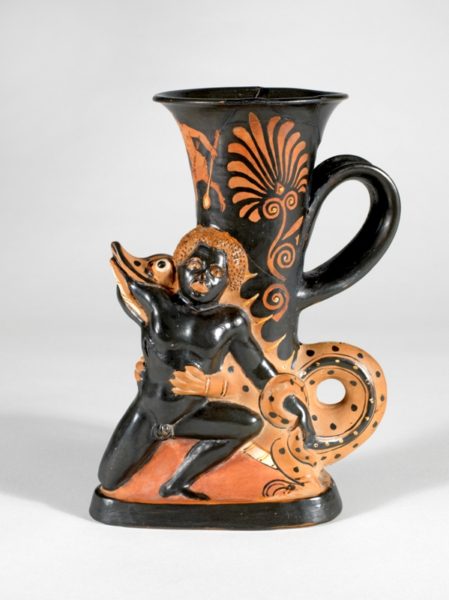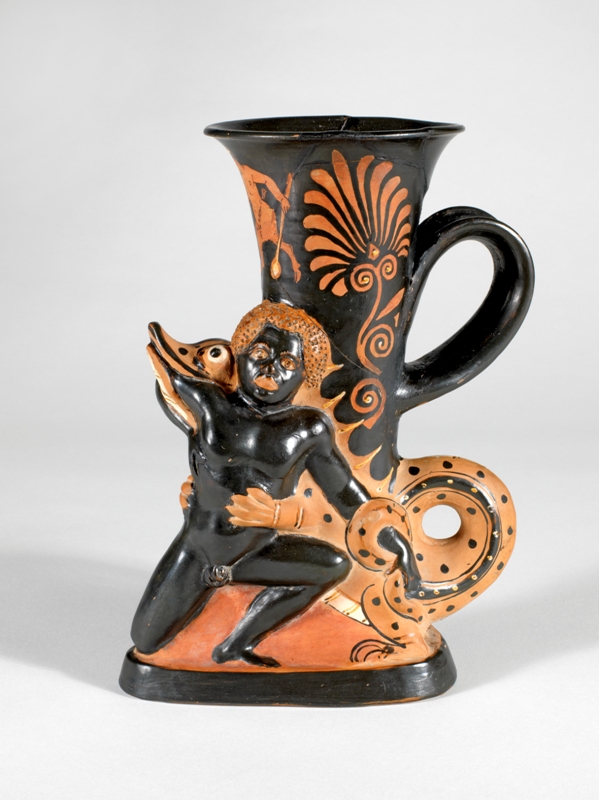How the Greeks depicted the people of Kemet


For the ancient Greeks and Romans their contemporaries in Egypt were different. This is evidenced through descriptions of people from Kemet and also how both Greek and Roman artists depicted people from Africa. The rhyton above is a case in point. This drinking cup was manufactured in the Italian region of Apulia (below highlighted in red), which was home to colonies of Greek people.

The cup above shows a figure of a man, who by the colour of his skin and hair can be identified as being of indigenous African descent, who is being attacked by an animal. The scales on the back of the beast, its tail and its snout identify it as a crocodile; although it would appear as often seems to have been the case that the artist had never actually seen a crocodile but was perhaps basing the representation on descriptions or other works of art. What is remarkable about this particular crocodile is that it wears anklets. This is perhaps a practice that was referenced in a passage in Herodotus’ Histories:
For some of the Egyptians the crocodiles are sacred animals, and for others not so, but they treat them on the contrary as enemies: those however who dwell about Thebes and about the lake of Moiris hold them to be most sacred, and each of these two peoples keeps one crocodile selected from the whole number, which has been trained to tameness, and they put hanging ornaments of molten stone and of gold into the ears of these and anklets round the front feet, and they give them food appointed and victims of sacrifices and treat them as well as possible while they live, and after they are dead they bury them in sacred tombs, embalming them: but those who dwell about the city of Elephantine even eat them, not holding them to be sacred. They are called not crocodiles but champsai, and the Ionians gave them the name of crocodile, comparing their form to that of the crocodiles (lizards) which appear in their country in the stone walls.
(Herodotus Histories 2:69)
The crocodile became synonymous with Egypt for Greek and later Roman artists and there are both vases and stone sculptures that depict humans who look very similar to the one illustrated here, accompanied by crocodiles. It is also true if we look at text references to Egypt or Egyptians, that Greek writers saw no real difference between those people from Egypt and those from Ethiopia. In fact the Greek word Aethiops, from which Ethiopian derives, means ‘burnt face‘, presumably because the Greeks who encountered African people saw them as different to themselves.
Many readers will be familiar with another quote from Herodotus (Histories 2:104) that makes reference to the appearance of the people of Kemet having dark skin (melanchroes) and curly (often translated as ‘woolly‘ on account of the word ‘oleos’.
A survey of commentaries on the use of these words and their suggested translations reveals some degree of subjectivity on behalf of many authors. In his 1988 commentary on Herodotus Book 2, Alan Lloyd writes the following about the use of the word melanchroes:
There is no linguistic justification for relating this description to negroes [sic.]*. Melanchroes could denote colour from bronzed to black and negroes [sic.]* are not the only physical type to show curly hair
* this is the term that is used in the commentary, it is not one that I condone or would choose to use.
Once again we find ourselves back to the supposition that every person of African descent has (literally) skin that is black in colour, rather than acknowledging that African peoples have, and are today described as, light skinned, dark skinned, and in the case of the Caribbean red skinned (although this means very light). See an earlier post where I discuss how Egyptologists are keen to differentiate between Egyptian/Kemite and Nubian/Kushite people.
The use of a term to describe the hair that includes the word for wool would suggest that the hair of the ancient Egyptian people was textured and different from that of the Greeks. The reference to dark skin also accords with representations such as the vase above.
The artists’ representations for me speak for themselves. I would not classify myself as a philologist but I did study Ancient Greek for my first degree. The fact that the term melanchroes covers a variety of dark skin colours as pointed out by Lloyd, supports that argument that the people of ancient Kemet were indigenous African people, and that they represented the variance that we find amongst African peoples today.


Hotep; and add to that the fact is that Kemet was invaded by the Hyskos; Assyrians; and others centuries before the Greeks entered the fray. Therefore; as one of the staples of invasion and occupation is the mass raping off the wombmen, in order to turn the oppressed population into your own people.
Agreed. This is essentially what the Black Kemets did to the Greeks, only they took it to a much higher and sophisticated level. To this day, Greeks develop sickle cell anemia and various skin ailments found only elsewhere in sub-Saharan Africa. Several international universities and research centers place the Greek DNA haplogroup in with Ethiopians and Nigerians, and not with other Mediterraneans. Even Herodotus wrote of “the ebon skinned and woolen haired invaders from beyond the southern deserts who subjugated the early Hellenes (Greeks), and proceeded to colonize, civilize and acculturate them”. To deny the Black African roots of Greek civilization is simply ludicrous, delusional, and outright racist. I say this as a Greek.
Indeed, it is important to separate the Kemets Black Africans) from the Greeks whom they invaded, conquered, colonized and civilized. Some Afrocentrists go too far in claiming that the ancient Greeks themselves were Black. That is not true. The Greeks learned from and emulated their Kemetic masters, but were in fact White. This is also important to note in that it marked at least one historical instance in which a White people (the Greeks) were ruled over by a Black people (the Kemets).
I do believe the Greeks referred to Egyptians as black- or dark-skinned, and I know of one quote from a pseudo-Aristotelian text that grouped Egyptians and “Aethiopians” together as dark-skinned peoples (saying, “those who are too black, like Egyptians and Aethiopians”, are cowardly…”). However, I am under the impression that the Greeks did treat Egyptians and “Aethiopians” as different nationalities, with the latter correlating with the kingdom of Kush. Do you know of any texts which totally conflate Egyptians with “Aethiopians” in the way you describe?
There is the pseudo Aristotle and Herodotus culturally links the two. Diodorus Siculus also makes reference to the origins of the Egyptians as colonists from Ethiopia. It is really in the representations of Ethiopians and Egyptians for example Memnon and Amasis (the earliest examples are on Black figure vases that were manufactured in Athens) where we see no distinction at all between the two.
Were the ancient Egyptians variations of darker skin tones or were they all just black skinned? Confused!
I am confused by the previous comments above, when the Greeks spoke about Ethiopians( people of Burnt faces) were they referring to a land where everyone was black skinned in complexion or were they referring to people of darker skin tones where there is variations( Black skinned like a Dinka to Caramel like a Khosian). For instance when we say Black people today not referring to the black skin tone but variations of darker skin tones whether brown or black mainly looking for a particular phenotype.
Hi Stephine. The Kemite people show themselves with a range of different skin colours and also hair types. As you would expect when any people are representing themselves, they will tend to show a wider range of the population. However, when Europeans were depicting anyone from the African continent they tend to show them as one end of the scale, which would be darker. Partly this would be because artists needed anyone looking at their work to know instantly that this was an Egyptian or Ethiopian and people who had never been to Africa would have heard stories about the population there and so would replicate what they believed all Egyptians to look like. There are some interesting paintings from Pompeii that show crocodiles. And clearly the artist had never seen one but had been told of the main features (big teeth/scales)- the result looks more like a dinosaur than a crocodile, but anyone seeing that painting would know what it was. If we go back to the Kemite artists, they always depict other people such as the Kushites or Libyans in the same way- it’s almost like an accepted ‘type’. In reality not everyone looked the same. To bring it to today’s context, most White people when describing someone who is of African heritage would say they were Black; however, I’m sure there as elsewhere in the Caribbean people will describe people not at ‘Black’ but by skin tone: light skinned/dark skinned. Unfortunately, Egyptology seems to follow the ancient European viewpoint that African people need to fit a certain ‘type’ and that the ancient Kemites do not fit this preconceived idea of what is and isn’t indigenous African. That’s a bit of a convoluted answer, but does that answer you question?
Yes it does.Thank You… Sometimes people use terms like negro to describe “Black” people. ” That negro boy” you know.
I would hope not, in the twenty-first century! ‘Black’ is of course cultural as well as a racialised term. Although I think it is probably used more frequently for the African Diaspora, perhaps I’m just assuming that. The earliest use of the term Black in reference to people that I have found in the UK dates to 1507. A musician in the court of Henry VIII named John Blanke was described as the ‘blacke trumpeter’ and there is a depiction of him showing that he was indeed of African descent.
Yea, people still call us negro. But majority of the time people say black. Its hard when someone says that but the information about understanding black history is not something that interest lots of people. It’s either it has never crossed their mind or they don’t care.
This is why I feel that Black history is so important for everyone to know about.
They clearly were black people.
I am inclined to believe the Greek characterization of “melanchroes” meant “black” for the people of Kemet (and for that matter Kush, Libya, most of the Western Asian population, and into India) because these areas had the darkest people known to the Greeks – who themselves and even as evidence by contemporary genetics of modern-day Greeks were/are a mixed ancestry population between Europe, Western Asia, and Africa. The term did indeed mean black. Otherwise words that are related to “Melanchroes” would contain those same “bronze or brown color” meanings but they do not: Melano, Melas, Melanin, Melanesia, etc. all have “black” in their core meaning even when the actual ethnic groups from these regions would have including Africans from a range of brown hues. When Herodotus in Book II uses a “melas” related word (μελαίνας) to characterize two doves spreading religion from Thebes to Libya lower Egypt and Greece; there in no way is any attempt to have that textual reference re-translated as “dark” or as a brown dove or bronze dove much less a dark dove but only a black one. The ancient text is clear in its artistic representations of these indigenous Africans of Kemet as well as in their written word which also links with the genetic studies that indicate the 20th Dynasty and 18th Dynasty would be characterized as “black” and “Sub-Saharan African” today.
Hi Deidra, thanks for your comment. I wasn’t agreeing with the Lloyd commentary, my point was that however we translate the adjective it shows that the Ancient Greek people saw the Egyptians as different to themselves in both their appearance and culture. The doves in Herodotus book 2, chapter 69 are problematic in their own right, in that they have been identified as collared doves by commentators, so that doesn’t really help when trying to counteract Eurocentric interpretations. I feel that we are quite restricted in translating ancient languages, because we often have a lesser or wider range of words that cover a single ancient word or vice versa. When you look in the Greek lexicon ‘Melas’ certainly references black (and dark) as a colour. As you will know from looking at the lexicon the nuances can also change depending on the period, but once again these are also often references of people’s interpretations of the language. The reason that I am being cautious here (in terms of the language) is partly my own academic bias (I have a degree in Ancient Greek but am more confident when dealing with the interpretation of material culture) and because I feel that in order to combat Eurocentric interpretations of Ancient Egypt/Kemet counter arguments need to be really strong, so for that reason I will quite often err on the side of caution. From your point of view the use of ‘Melas’ is strong enough only to mean ‘black’, so thank you so much for contributing this- it’s great for readers to see other informed interpretations.
I understand your caution. My question would be what other word did the Greeks used to describe African people characteristically aside from “Melas” and then depict them in their artwork as the most dark of Africans even though we know they were a range of browns? It seems the Greeks set as their standard the darkest skin toned Africans in skin color and most coarse hair depictions to emphasis the extreme of who were “Melas” for certain. It isn’t as if the vast majority of Aithiop depictions are of light brown to medium brown Africans even when they existed in Kemet and north Africa. So, from my viewpoint, the expansion of the term “bronze to brown” for Melas without any depictions to represent that since the Greeks themselves had citizens in the bronze category is an attempt to alter the original meaning as it relates to the people they depicted in their bronzes. I mean, I believe either melanos or melano relates to a word origin for black ink not bronze or brown ink and the Greeks had words for brown which at least one Greek writer Ammianus Marcellinus, Book XXII used to described the Ancient Egyptians as brown or black men who were skinny. So, if Melas already encompasses a wide spectrum of black, brown, and bronze colors then why does Marcillinus use “brown” to define what he sees and is there any evidence of the Greeks using Melas related words to describe non-African origin Greek skin color since many of them would have been bronze or as Aristotle put it …. between being too black or too white a hue?
Hi Deidra, thanks for this because it has made me go back to my dictionaries. The word for brown is also ‘melas’ and this was what I meant about limitations within languages. Other variants for brown are ‘xanthos’ which is generally translated as yellow. We may have a number of words for different shades of similar colours but not all languages do. Melas was the most common word I could find for brown or black, also dark and it is the one that is used to describe African peoples, but I haven’t found it used for non-African peoples. The word for bronze as a material is quite different though. But I do take your point, certainly from all representations the Ethiopians and Egyptians are depicted with jet black skin and features that are different to the ancient Greek depictions of their own people. And melas is dark brown or black compared to ‘xanthos’ which seems to be a lighter brown.
Hello, I’m trying to educate myself on the origins of the N word. and this is where I ended and I’m glad I did. What are some good sources where I can find all this knowledge you all have ?